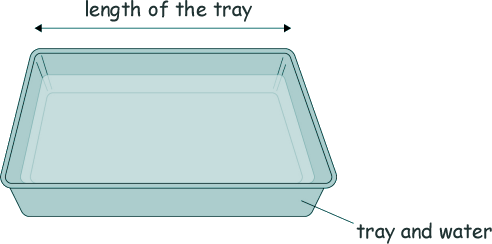GCSE Questions - Waves
Q16. (a) The diagram shows some waves.

(i) Which arrow represents the wavelength of the waves?
[1 mark]
(ii) Which arrow represents the amplitude of the waves?
[1 mark]
(iii) The waves have a frequency of 0.20 Hz.
Calculate the period of the waves.
[2 marks]
(iv) The frequency of the waves is increased.
The speed of the waves stays the same.
What happens to the wavelength of the waves?
[1 mark]
(b) Jess investigated how the speed of water waves is affected by the depth of water in a tray.
The diagram shows some water in a rectangular tray.

Jess lifted one end of the tray and then dropped it. This made a wave which travelled the length of the tray. She measured the length of the tray.
(i) Which of the measurements listed in the table should she also measure in order to calculate the speed of the wave? Tick one.
| Area of the bottom of the tray |
|
| Depth of water in the tray |
|
| Temperature of the water in the tray |
|
| Time taken by the wave to travel the length of the tray |
|
[1 mark]
(ii) Tick the variable that was the 'independent variable' in this investigation.
| Depth of water |
|
| Length of tray |
|
| Speed of waves |
|
[1 mark]
(iii) The graph shows Jess's results.

Give one conclusion that can be made from the graph
[1 mark]
(iv) Use the graph to determine the speed of a wave when the depth of water was 2.5 cm?
[1 mark]
(Total 9 marks)










